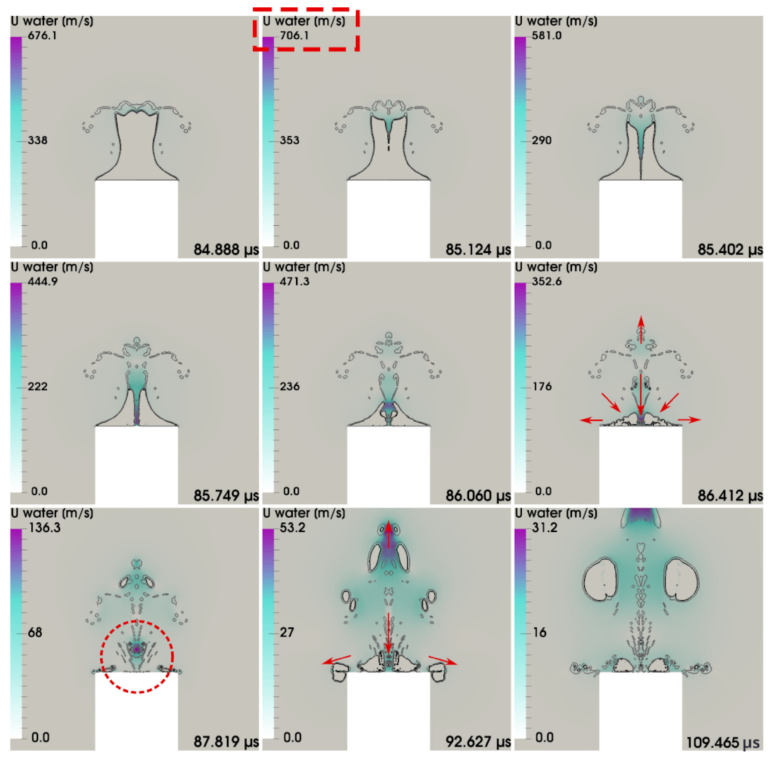A tiny bubble popping within a liquid seems more fanciful than traumatic. But millions of popping vapor bubbles can cause significant damage to rigid structures like boat propellers or bridge supports. Can you imagine the damage such bubbles could do to soft human tissues like the brain? During head impacts and concussions, vapor bubbles form and violently collapse, creating damage to human tissue. Purdue University fluid mechanics researchers are now one step closer to understanding these phenomena.
“When a bubble collapses inside a liquid, it generates pressure shock waves,” said Hector Gomez, professor of mechanical engineering and principal investigator. “The process of forming a vapor cavity and its collapse is what we call cavitation.”
“Cavitation has been studied since the 1800s,” said Pavlos Vlachos, the St. Vincent Health Professor of Healthcare Engineering and director of the Regenstrief Center for Healthcare Engineering. “It’s a very complex field of study because it involves non-equilibrium thermodynamics, continuum mechanics, and many other factors on a scale of micrometers and microseconds. After hundreds of years of research, we are only just now starting to understand these phenomena.”
Even less is known about bubbles that collapse in soft porous materials, such as the brain or other body tissues. That’s significant, because understanding how those bubbles behave could lead to a better understanding of concussions—or even be used to deliver targeted medications inside the body.
In new research published in the PNAS Nexus, Gomez, Vlachos, and collaborators presented the development of a mathematical model to describe the dynamics of these cavitation bubbles in a deformable porous medium.
Cavitation occurs throughout the human body—for example, cracking your knuckles is the sound of bubbles popping in your joints’ synovial fluid. When the fluids inside the body are subjected to pressure waves—such as when football players endure head impacts—bubbles could form in the fluid surrounding the brain. And just like the bubbles that damage boat propellers, bubbles bursting near the brain could damage its soft tissue.
“The human brain is like a water-filled squishy sponge; it has the consistency of gelatin,” said Vlachos. “Its material is porous, heterogeneous, and anisotropic, creating a much more complex scenario. Our current knowledge about cavitation doesn’t apply straightforwardly when such phenomena occur in the body.”
Gomez and collaborators developed a theoretical and a computational model showing that the deformability of a porous material slows the collapse and expansion of cavitation bubbles. This breaks down the classic scaling relation between bubble size and time.
“Our model embeds the bubbles into deformable porous materials,” said Yu Leng, the first author of the paper and postdoctoral research associate working with Gomez. “Then we can extend the study of cavitation bubbles in pure liquid to soft tissues such as the human brain.”
While complex, this model can also be reduced to an ordinary differential equation. “A hundred years ago, Lord Rayleigh developed the equation that describes the dynamics of a bubble in a fluid,” said Gomez. “We were able to augment that equation to describe when the medium is poroelastic. It’s pretty amazing that these complex physics still lead to a simple and elegant equation.”
Gomez and Vlachos are currently planning experiments to physically validate their results, but they are also looking to the big picture. “One potential application is targeted drug delivery,” said Gomez. “Let’s say you want to deliver a drug directly into a tumor. You don’t want that medication to disperse elsewhere. We’ve seen encapsulations that keep the drug in isolation until it has reached its target. The encapsulation can be broken by using bubbles. Our research provides a better understanding of how these bubbles collapse in the body and can lead to more effective drug delivery.”
“Another example of future possibilities is traumatic brain injury,” Leng said. “We can extend this research to study the impact of uncontrolled cavitation collapse on brain tissue, when military personnel and civilians are exposed to blast shock waves.”
Gomez and Vlachos say they are thrilled to establish new foundational science for understanding bubble dynamics in soft porous materials. “This opens up all sorts of possibilities for future research,” Gomez said, “and we look forward to how we and others will use this knowledge in the future.”
More information:
Yu Leng et al, Cavitation in a soft porous material, PNAS Nexus (2022). DOI: 10.1093/pnasnexus/pgac150
Citation:
Brain bubbles: Researchers describe the dynamics of cavitation in soft porous material (2022, August 30)
